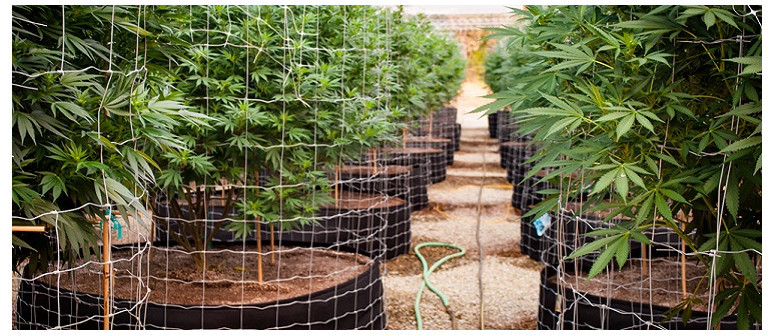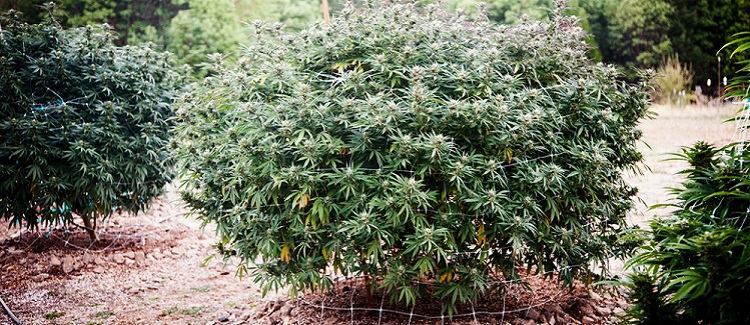The fine art of trellising your marijuana plants

Trellises are cheap and simple structures, but they are highly effective at supporting cannabis plants. They also serve to open up the canopy, and in doing so, boost light exposure and airflow.
Trellises are criss-cross structures used to guide and support the growth of plants. They are particularly useful in vegetable gardens when it comes to vines such as gourds and cucumbers. These plants crawl all over the structures, and in doing so, provide a much larger yield than had they just been left to grow across the ground.
Trellises also help utilize the space available to growers, greatly enhancing the total surface area of a garden. These structures have found their way into the cannabis world due to their cheap cost, simplicity, and effectiveness.
STRUCTURAL SUPPORT

Cannabis growers use these structures primarily to support their crops. Strains that have been selectively bred to produce massive yields have the tendency to become top heavy, making them vulnerable to strong winds. Trellises can be used to prevent stems from snapping and entire plants from toppling over.
Although it is good practice to moderately stress plants and not provide too many potential crutches, it's far better to provide a structure for your plants to lean on than to run the risk of any monster-yielders taking a dive into the soil or snapping.
LIGHT DISTRIBUTION
Trellising cannabis plants is a great way to boost even light distribution. When left to their own devices, cannabis plants grow directly upwards, with not much lateral growth occurring. This enables them to grow closer to the life-giving light source, but can also lead to crowding, uneven light distribution, and lower yields.
Cannabis plants grown outdoors may receive adequate light regardless, as the sun moves across the sky in the day. Indoor plants, on the other hand, usually have to deal with a static light source, potentially leaving some bud sites and leaves in the dark.
Using a trellis, along with techniques such as pruning and topping, will open up and spread out the canopy, creating much more space. This structure is optimal for supporting higher-quality yields, as all of the buds and leaves receive ample amounts of light.
AIRFLOW
A more open canopy means improved airflow, which is an extremely important tenet of cannabis growing. Air is one of the basic building blocks of plant life. Plants are able to breathe, or respire, through their stems, roots, and leaves. Problems within the domain of airflow can lead to a weakened plant structure, increased stress, and decreased flower density.
Airflow is paramount within indoor grow spaces to constantly eliminate stagnant air and to introduce fresh air. An open canopy will allow for adequate airflow without restrictions or stagnant pockets occurring. All of the leaves will have good access to fresh air currents.
MAKING A TRELLIS
Making a trellis is extremely easy, and it can be done using many different materials. Those who are short on time but have the budget can simply purchase a wooden or metal trellis from a gardening center to save them the effort. However, those who don’t want to spend the extra money can simply make their own.
HORIZONTAL TRELLIS - SCROG
The key to creating a trellis is the grid pattern. Perhaps the simplest way to achieve this is to obtain bamboo gardening canes and tie them into grid patterns using string. To make a horizontal trellis, first install several vertical support beams to hold up the horizontal grid.
Make the grid and bind it to the vertical supports so it lays over the grow space in a horizontal fashion. The shape of this structure is similar to that of a table. Multiple legs or supports hold up the horizontal lattice structure.
The height at which you place the horizontal grid greatly depends on the height that your plants will achieve (and the height of your grow space), therefore, it’s best to wait further into the vegetative phase to put them in place, unless you are very familiar with the strain in question.
Eventually, your plants will start to grow and diverge into the trellis. The upper branches will be supported, free of the risk of snapping or toppling during the flowering phase. This horizontal trellis is also commonly known as a ScrOG or screen of green—a time-tested cannabis training method.
VERTICAL TRELLIS
A vertical trellis uses the same lattice structure. Vertical trellises are usually cylindrical in shape and more often used outdoors. They fulfill the same function, but offer the branches lateral support instead.
The easiest way to erect these is to purchase metal netting and shape them around plants. However, this is budget-dependent. These structures can also be made on the cheap with a bit of craftsmanship.
One way to do so is to create 4 criss-cross grids and create a cube shape around plants. This can also be made out of bamboo canes and string.
Alternatively, fresh and young tree branches can be used to create ring structures around plants. Place 3 bamboo canes at the base of a plant to form 3 points of an equilateral triangle. Then, install the rings between these supports using string. Use anywhere from 3 to 6 rings depending on how much support your plants need.




